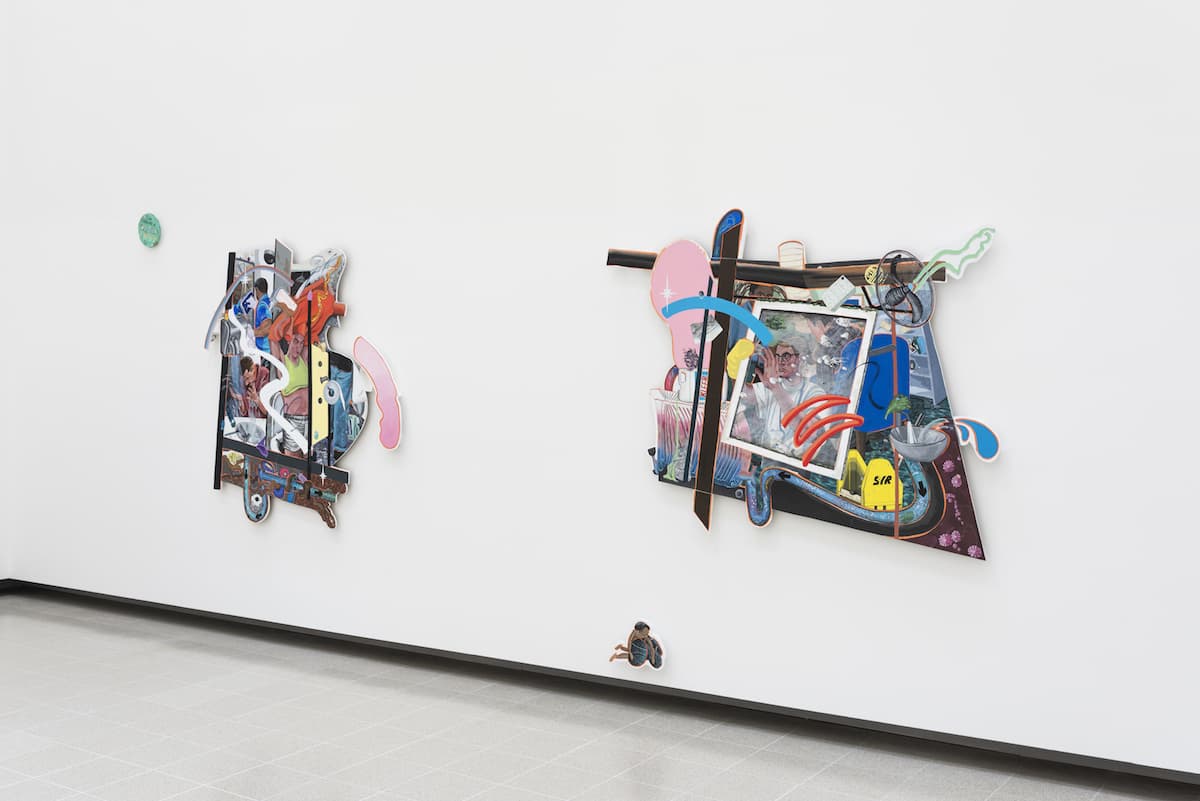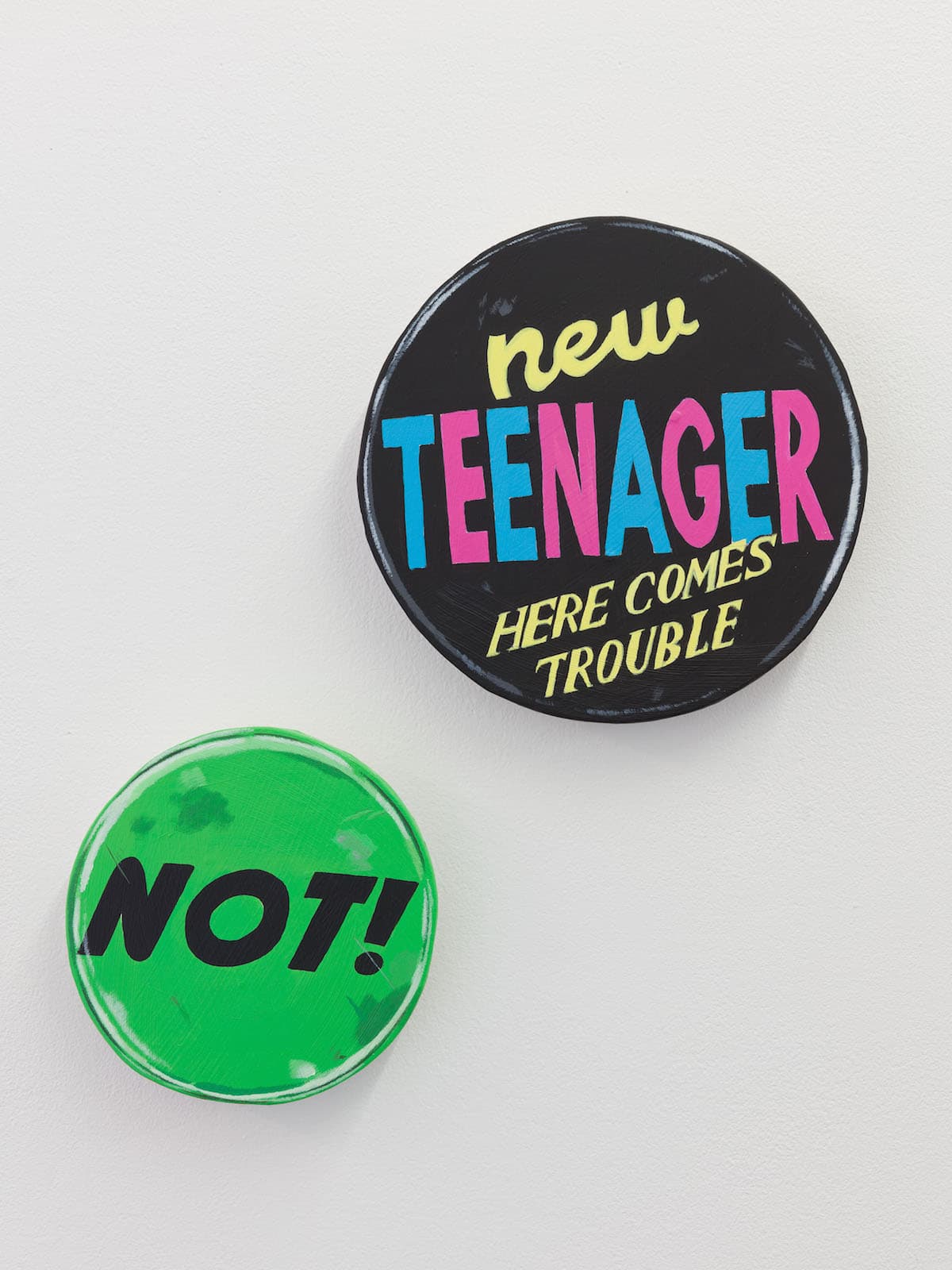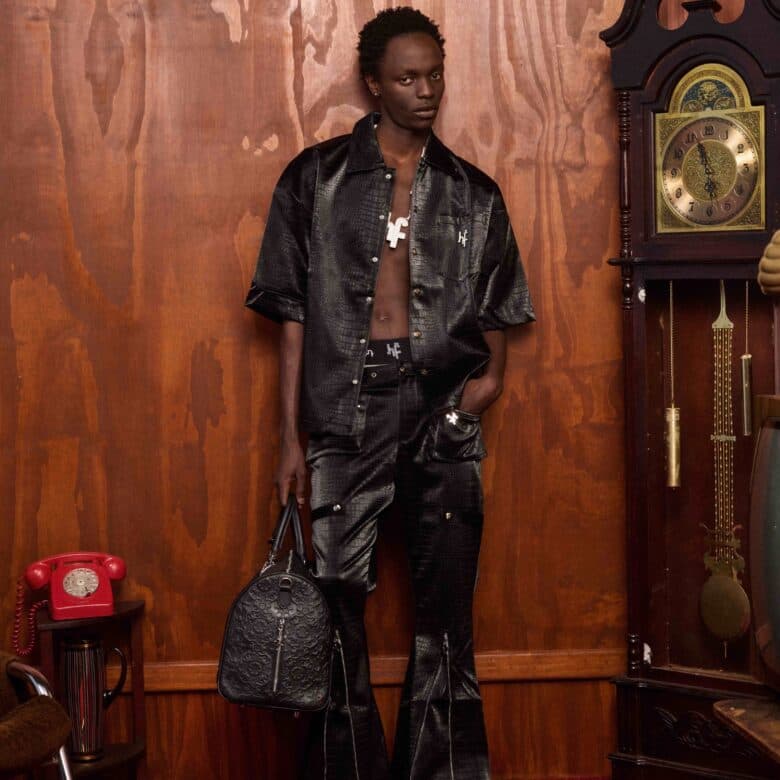Flo Brooks’ paintings playfully pick apart our “mindlessness under capitalism”
Whilst the likes of Lydia Blakeley, whose wryly kitsch work is gaining cult status, might be reinitiating a vogue for painting, it’s artists like Flo Brooks who show what the medium can really do. Creating dense snapshots of contemporary Britain spilling over with idiosyncrasies, he invites the viewer to look anew at today’s social issues through the witty details dotted throughout his works. Whether he’s creating tableaus of fictional cleaning companies at work to examine themes around hygiene rituals, labour and “correct” bodies or consecrating pithy badge slogans from his youth with large-scale paintings, he seamlessly links the micro and the macro in more ways than one.
As he unveils three new paintings in the London edition of art festival Condo, we sat down to discuss the role of humour in his work, his thoughts on capitalist realism and his interest in 17th century Dutch paintings (of all things).
Could you discuss the role of humour in your work?
Humour seems to me to be a leveller, it draws people in and it’s generous (not talking about snarky sarcasm though!) it feels like a constructive way of approaching “social issues” without immediately turning people off. It can provide a contrast or tension in a work when held against a more sober or earnest motif, there are so many different tempos and forms to it that can effect a composition, or a signifier, or a mood in a painting, and that’s exciting. In myself I tend to oscillate between daftness and sincerity, but I think I suppressed a lot of the daftness for most of my younger years. As I felt more comfortable about myself over time, and many comings out later, I definitely loosened up, and that loosening manifested in a stronger sense of humour and play in the things I made, they then tended to feel more fully formed, and more potent in a way. I think like everything it just keeps evolving and shifting.
As well as humour, how does play operates in your work?
Play is an odd word, and if I’m honest one I sort of baulk at. I think anyone that went to art school will probably recoil because it’s so cemented into the art lexicon, and it’s become so meaningless as a result. Also I can’t help but associate it with well-being culture, like “tapping into your inner child”, and in that regard it feels so prescriptive. But I do understand why it can be a convenient term, and why it might be suggested with particularly the kind of painting I do. There’s a certain amount of playing I do when making a painting, once I’ve established my own set of rules, a kind of framework to work under and shape. My intention is always that by introducing different elements, textures, relationships in the paintings, these interactions will be instilled with enough energy to continue to riff off and change one another, way after they leave my studio.

You’ve previously said that your work looks at “mindlessness under capitalism”. Could you elaborate on this please?
I think I was alluding to the kind of daily drudgery at play under capitalist-realism; what Mark Fisher talked a lot about in his book Capitalist Realism: is There no Alternative? from 2009. We’re at a point where it’s literally impossible to imagine an alternative to our current economic system. That book’s over 10 years old now, and so much has happened since it was published, but it still feels so pertinent. For me it always comes back to how living under capitalism actually affects mine and other people’s lives, and trying to make sense of it through the material world. How might I read that on someone’s face or in the way they move their body or how they inhabit a space and interact with other people? What space is even accessible to them and at what cost? The decisions they’lI make. When we are spent, when we check out, when we haven’t the means or energy to implement change, and when we do regardless of the impact it’ll have on our physical and mental health. You could probably read all that as being interested in how and what people do to survive.
Would you be able to discuss the concern with cleanliness and hygiene within your work, particularly in the work produced for your 2018 solo show “Scrubbers” at Project Native Informant?
I had several threads I wanted to pick apart whilst creating those paintings. For one I was interested in the relationship between hygiene and non-normativity, and looking at the ways hygiene has been utilised as a socio-political project throughout history to colonise and sanitise “otherness”. I wanted to consider the extent to which these beliefs are still very much in use today, what my experience as a queer AFAB trans person was like occupying these “legitimised” hygienic spaces, and what it felt like for my friends, family and community. The inclusion of brands used by the cleaners, and the things we consume to modify and maintain our bodies was just another way of teasing out less obvious, or more uncomfortable histories. Also asking where morality comes in, where you “draw the line”, one person’s “necessary” is another’s “too much”, and that’s so telling. Transphobic people often use the line of “its not natural” which always strikes me as so banal. What does that even mean nowadays, how would you begin to define that?

There’s also an interest in growing up in your work— specifically in your large-scale paintings of badges — could you talk about this please?
All of the badge paintings are scaled up versions of real-life badges I own. I’ve always had an interest in wearing and making them, and I tend to collect ones with fairly specific themes and sensibilities in mind. The paintings I made using these were under the late ‘90s early ’00s teenage bracket, basically the ones I would’ve seen and cringed at when I was going through my first puberty. When I was making a series of paintings for Cubitt a couple years ago one of the themes I was preoccupied with was puberty, and in the work I wanted to gesture towards my having started HRT [Hormone Replacement Therapy] and the experience of going through a second puberty as an adult.
One way of interrogating that was by looking at the objects and things I held in my possession, both as an 11-year-old starting puberty and then again as a 28-year-old, and badges were always present. They, like other objects I kept, felt so embodied with specific feelings surrounding my gender identity, expression and sexuality, feelings of shame and self-disgust, and of agency and empowerment. Scaling them up and painting them became a way of monumentalising something that can be worn so discreetly’ when you’re young and literally bursting to tell the world you’re queer or whatever and the badge becomes this tentative first step. Maybe you’ll wear it under your jumper for yourself, or maybe you’ll take your jumper off and people will actually be able to see it!

Could you talk us through the works you are showing as part of Condo please?
I’m showing three acrylic on board paintings for Condo. One is a large figurative scene entitled The sweet spot, the other two are smaller works, Crazy world aint it and Beware! This is an erogenous zone.
In the large work, I was thinking about the absence of certain public amenities in the towns I visit on a fairly regular basis, particularly those in the Westcountry. How they’ve been shut down and boarded up over the last 10 or so years, especially in the likes of Cornwall, which I think had something like 94% of its public toilets closed since the Liberal-Conservative coalition came into power. The public toilet for me is a kind of paradoxical space of otherness and contradiction. One tightly wound up in histories of violence and segregation but also a space where different bodies could come together and feel desired, wanted, witnessed. It also felt like quite a clear marker of how issues such as austerity, gentrification and privatisation have been felt by people, and a constructive framework in which to explore some of these ideas.
The smaller works are partly influenced by 17th century Dutch paintings that used the window as a pictorial motif. It was a prominent site of social exchange in the neighbourhood at this time, and I really love the paintings from this era as they tend to reveal these buoyant and enlivened exchanges between neighbours and traders, lovers and family members, surrounded by animals, and articles rich in symbolism. I was imagining how I might paint a window today, what it might say about community or society at large and how people interact with and in relation to it. The UK today feels unnerving and hostile, so they’re not sites of active social exchange but of isolation and detachment, people don’t peer out but remain closed off and solitary, engaged in a task in semi darkness. I think we as a human species are so conceited generally, so wrapped up in our own lives, so only a snake and a fox slip in and out of the window frames, whilst fungi and weeds poke out through holes searching for light.
Flo Brooks is showing work as part of art festival Condo London 2020 at Project Native Informant until 8 February. Further information about Condo London can be found here.





